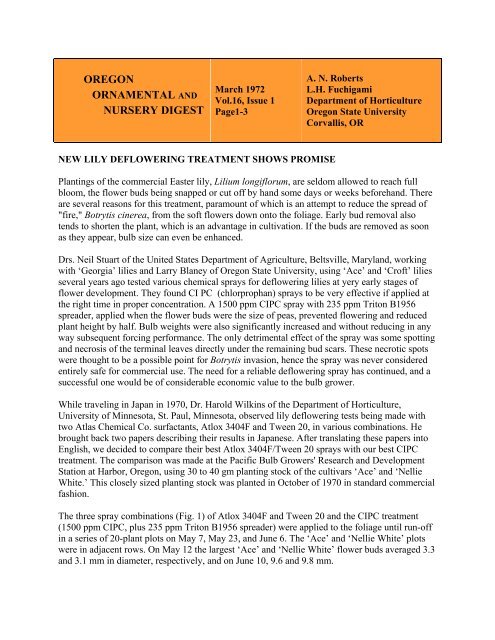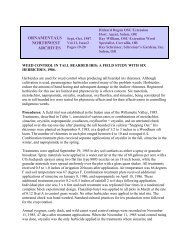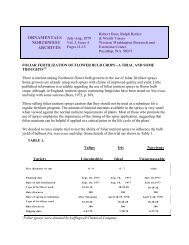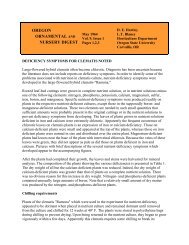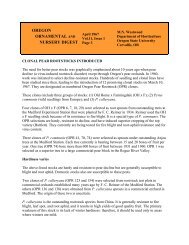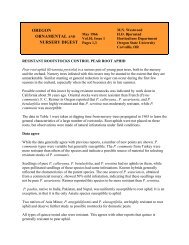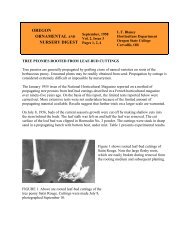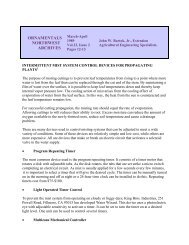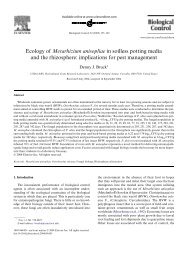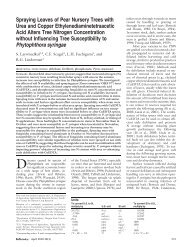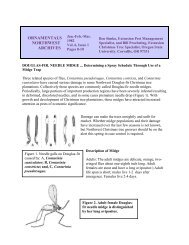New Lily Deflowering Treatment Shows Promise, Vol. 16, Issue 1
New Lily Deflowering Treatment Shows Promise, Vol. 16, Issue 1
New Lily Deflowering Treatment Shows Promise, Vol. 16, Issue 1
- No tags were found...
Create successful ePaper yourself
Turn your PDF publications into a flip-book with our unique Google optimized e-Paper software.
OREGONORNAMENTAL ANDNURSERY DIGESTMarch 1972<strong>Vol</strong>.<strong>16</strong>, <strong>Issue</strong> 1Page1-3A. N. RobertsL.H. FuchigamiDepartment of HorticultureOregon State UniversityCorvallis, ORNEW LILY DEFLOWERING TREATMENT SHOWS PROMISEPlantings of the commercial Easter lily, Lilium longiflorum, are seldom allowed to reach fullbloom, the flower buds being snapped or cut off by hand some days or weeks beforehand. Thereare several reasons for this treatment, paramount of which is an attempt to reduce the spread of"fire," Botrytis cinerea, from the soft flowers down onto the foliage. Early bud removal alsotends to shorten the plant, which is an advantage in cultivation. If the buds are removed as soonas they appear, bulb size can even be enhanced.Drs. Neil Stuart of the United States Department of Agriculture, Beltsville, Maryland, workingwith ‘Georgia’ lilies and Larry Blaney of Oregon State University, using ‘Ace’ and ‘Croft’ liliesseveral years ago tested various chemical sprays for deflowering lilies at yery early stages offlower development. They found CI PC (chlorprophan) sprays to be very effective if applied atthe right time in proper concentration. A 1500 ppm CIPC spray with 235 ppm Triton B1956spreader, applied when the flower buds were the size of peas, prevented flowering and reducedplant height by half. Bulb weights were also significantly increased and without reducing in anyway subsequent forcing performance. The only detrimental effect of the spray was some spottingand necrosis of the terminal leaves directly under the remaining bud scars. These necrotic spotswere thought to be a possible point for Botrytis invasion, hence the spray was never consideredentirely safe for commercial use. The need for a reliable deflowering spray has continued, and asuccessful one would be of considerable economic value to the bulb grower.While traveling in Japan in 1970, Dr. Harold Wilkins of the Department of Horticulture,University of Minnesota, St. Paul, Minnesota, observed lily deflowering tests being made withtwo Atlas Chemical Co. surfactants, Atlox 3404F and Tween 20, in various combinations. Hebrought back two papers describing their results in Japanese. After translating these papers intoEnglish, we decided to compare their best Atlox 3404F/Tween 20 sprays with our best CIPCtreatment. The comparison was made at the Pacific Bulb Growers' Research and DevelopmentStation at Harbor, Oregon, using 30 to 40 gm planting stock of the cultivars ‘Ace’ and ‘NellieWhite.’ This closely sized planting stock was planted in October of 1970 in standard commercialfashion.The three spray combinations (Fig. 1) of Atlox 3404F and Tween 20 and the CIPC treatment(1500 ppm CIPC, plus 235 ppm Triton B1956 spreader) were applied to the foliage until run-offin a series of 20-plant plots on May 7, May 23, and June 6. The ‘Ace’ and ‘Nellie White’ plotswere in adjacent rows. On May 12 the largest ‘Ace’ and ‘Nellie White’ flower buds averaged 3.3and 3.1 mm in diameter, respectively, and on June 10, 9.6 and 9.8 mm.
The effects of the sprays on the above-ground portions of the plants were evident throughout thegrowing season. The subsequent effects of the various treatments on percent deflowering, plantheight, and final bulb weight is evident in Figures 1, 2, and 3. On September 13, the bulbs wereharvested and stored for future greenhouse observation during forcing.It is evident that timing is an important factor in the deflowering effectiveness of the spraycombinations (Fig. 1). It is apparent that the two later sprays, May 23 and June 6, were moreeffective in aborting the buds than the one applied earlier. When treated on May 23, all sprayswere more effective with ‘Nellie White’ than ‘Ace.’ When properly timed, the Atlox/Tweensprays were as effective as CIPC on ‘Nellie White’ but not ‘Ace.’ Possibly a higherconcentration was needed. Visually, the CIPC spray was more phytotoxic to the upper leaves(necrotic spots) than the new Atlox/Tween combinations. The effectiveness of the several spraytreatments in deflowering is reflected in the corresponding reductions in plant height (Fig. 2).The CIPC and Atlox/Tween sprays were very effective in reducing plant height as compared tothe controls.The effectiveness of these new spray combinations in deflowering ‘Ace’ and especially ‘NellieWhite’ with little or no foliage damage is encouraging enough to warrant further refinements inthe treatments. A more extensive study of spray concentrations and timing as related to buddevelopment and weather conditions is in order.Figure 1. Effectiveness of deflowering treatments on ‘Ace’ and ‘Nellie White’ lilies duringthe 1971 season. Percentage of plants completely deflowered.<strong>Treatment</strong> Combination ‘Ace’ ‘Nellie White’Tween Atlox Date Applied Date Applied20 3404F 5/7 5/23 6/6 5/7 5/23 6/6 Averageppm ppm percent percent1. 2,5002. 5,000++5,00010,000------------- 10553540555301001001009043533. 6,000 6,000 -------------------- 15 65 20 30 100 50 47Controls4. *CIPC-1,500 ppm 55 90 100 95 100 100 903. No treatment --------------------------- 0 0 0 0 0 0 0Average---------------- 17 39 43 32 80 68*Effective CIPC treatment established in earlier trials: includes 235 ppm Triton B1956 spreader.
Figure 2. Effects of deflowering sprays on height (cm) of ‘Ace’ and ‘Nellie White’ liliesduring the 1971 season<strong>Treatment</strong> Combination ‘Ace’ ‘Nellie White’Tween Atlox Date Applied Date Applied20 3404F 5/7 5/23 6/6 5/7 5/23 6/6 Averageppm ppm centimeters centimeters1. 2,500 + 5,000 ---------------- 10.2 14.0 17.8 19.1 19.1 20.3 <strong>16</strong>.82. 5,000 + 10,000 ----------------- 12.7 14.0 <strong>16</strong>.0 14.0 17.8 17.8 15.43. 6,000 + 6,000 --------------- 10.2 15.2 15.2 17.3 15.2 <strong>16</strong>.5 14.9Controls9.7 12.7 15.2 <strong>16</strong>.0 12.7 14.0 13.44. *CIPC-1,500 ppm -----No treatment ---------------19.8 20.3 22.9 25.4 20.3 20.3 21.5Average------------ 12.5 15.2 17.4 18.4 17.0 17.8*Effective CIPC treatment established in earlier trials; includes 235 pm Triton B1956spreader.Figure 3. Effects of deflowering treatments on average bulb weight (grams) of ‘Ace’ and‘Nellie White’ lilies at harvest. (September 13, 1971)<strong>Treatment</strong> Combination.'A ce'`Nellie White'Tween AtloxDate AppliedDate Applied20 3404F 5/7 5/23 6/6 5/7 5/23 6/6 Averageppm ppm grams grams1. 2,500 + 5,000 --------------------------- 108 124 142 130 130 130 1272. 5,000 + 10,000 102 124 130 124 142 136 1263. 6,000 + 6,000 108 125 119 125 125 130 122Controls1344. *CIPC-1,500 ppm ------------------- 108 119 148 108 1141225. No treatment .................................. 108 103 136 114 119 119 117Average --------------------- 107 119 135 120 126 130*Effect EIPC treatment established in earlier trials; includes 235 ppm TritonB1956 spreader.Oregon Ornamental and Nursery Digest was published from 1957 to 1975 by the Agricultural Experiment Station,Oregon State University, Corvallis.Pesticide Use - Due to constantly changing laws and regulations, no liability for the suggested use of chemicals inthis reprint is assumed. Pesticides should be applied according to label directions on the pesticide container.Permission to Reprint material appearing in the Oregon Ornamental and Nursery Digest is granted with the requestthat you credit the source: Oregon Ornamental and Nursery Digest, date, volume, issue, page numbers. Do notexcerpt or reprint in such a manner as to imply the author's endorsement or criticism of a product or concept.Nondiscrimination - The information in the Oregon Ornamental and Nursery Digest is provided with theunderstanding that no discrimination is intended and that listing of commercial products implies no endorsement bythe authors. Criticism of products or equipment is neither intended nor implied.


